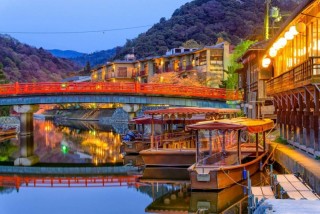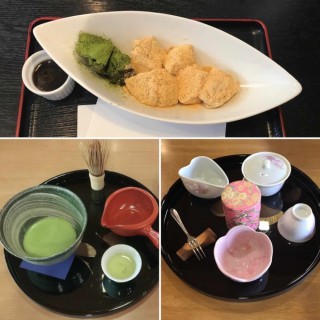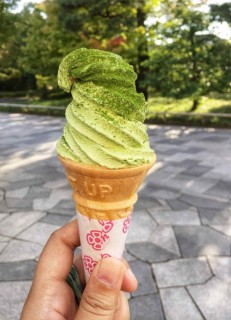Loading
Search
▼ Uji
- Category:Tourism
Home of the best green tea in Japan.
Mad about matcha? Go nuts for gyokuro (Japan’s most expensive green tea)? Then you simply have to take a trip to Uji City! Famous for producing some of Japan’s best quality green tea, it’s an unmissable destination for any fans of ocha. Tucked away just south of Kyoto City, this peaceful town is also home to one of Japan’s most stunning temples, Byodoin, whose image is featured on the back of the ¥10 coin.
The best place to go for all your tea-related needs is Omotesando. This narrow street leads the way to Byodoin Temple, and is lined with tea shops offering a wide range of different types of green tea – all locally sourced, of course. These are interspersed with restaurants serving all manner of green tea-flavored food, including soba noodles, ice cream and traditional Japanese sweets such as dango and warabimochi.
A short walk from Omotesando flows Uji, the river which divides the city in two parts. Venture across the Uji River and you’ll find several other tea houses where you can learn more about the production of green tea. Their resident tea masters will show you what makes Uji’s tea so special, and how to brew the perfect cup. Uji River also hosts river cruises during summer and cormorant fishing from the middle of June to late September. This traditional fishing method, where fishermen use cormorant birds to help them catch sweetfish (ayu), has been practiced for almost 1,300 years and is now a popular tourist attraction.
If you’re fond of Japanese literature, don’t miss the Tale of Genji Museum. This is dedicated to the classic novel by Murasaki Shikibu, which is partly set in Uji.
When the light hits the scene and you can see its elegant reflection mirrored in the large pond surrounding it, it’s easy to see why Byodoin was chosen to adorn the ¥10 coin.
It’s possible to see all of Uji’s main attractions in a day, making it a perfect day trip from Kyoto, Nara, or other nearby cities.
There are two main train stations in Uji: JR Uji and Keihan Uji. Both are centrally located, and they are only a 10-minute walk from each other.
From Kyoto station, you can take the JR Nara line directly to Uji (approximately 20 minutes). From JR Nara station, the journey takes about 30 minutes.
The tea of Uji
Uji has been known as one of the best tea-growing regions in Japan for almost 1,000 years and it’s reputation still stands strong today.The best place to go for all your tea-related needs is Omotesando. This narrow street leads the way to Byodoin Temple, and is lined with tea shops offering a wide range of different types of green tea – all locally sourced, of course. These are interspersed with restaurants serving all manner of green tea-flavored food, including soba noodles, ice cream and traditional Japanese sweets such as dango and warabimochi.
A short walk from Omotesando flows Uji, the river which divides the city in two parts. Venture across the Uji River and you’ll find several other tea houses where you can learn more about the production of green tea. Their resident tea masters will show you what makes Uji’s tea so special, and how to brew the perfect cup. Uji River also hosts river cruises during summer and cormorant fishing from the middle of June to late September. This traditional fishing method, where fishermen use cormorant birds to help them catch sweetfish (ayu), has been practiced for almost 1,300 years and is now a popular tourist attraction.
If you’re fond of Japanese literature, don’t miss the Tale of Genji Museum. This is dedicated to the classic novel by Murasaki Shikibu, which is partly set in Uji.
Temple treats
At the other end of Omotesando you’ll find Byodoin Temple (pictured above), Uji’s most Instagrammable spot and a World Heritage location. Its famous Phoenix Hall is breathtaking to behold, and one of the rare surviving wooden structures from the Heian period.When the light hits the scene and you can see its elegant reflection mirrored in the large pond surrounding it, it’s easy to see why Byodoin was chosen to adorn the ¥10 coin.
Nearby Uji
There are a number of other notable temples and shrines dotted around the town, including the Chinese-style Mampukuji Temple, and Mimurotoji Temple. The latter is also known as the “flower temple” thanks to its large gardens, which are planted with an abundance of seasonal flowers.Things To Know
Day Trippin'
It’s possible to see all of Uji’s main attractions in a day, making it a perfect day trip from Kyoto, Nara, or other nearby cities.The Tale of Genji Museum
The museum is open from 9 a.m. to 5 p.m. Admission for adults is ¥500 and there is information in English available at the museum.Byodoin Temple
The Byodoin Temple is open from 8:30 a.m. to 5:30 p.m. To enter the temple grounds, adults need to pay ¥600 and additional ¥300 to access the Phoenix Hall.How To Get There
By train
There are two main train stations in Uji: JR Uji and Keihan Uji. Both are centrally located, and they are only a 10-minute walk from each other. From Kyoto station, you can take the JR Nara line directly to Uji (approximately 20 minutes). From JR Nara station, the journey takes about 30 minutes.
- February 22, 2019
- Comment (0)
- Trackback(0)




